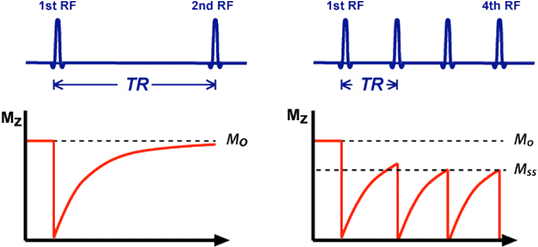The investigation of magnetic resonance imaging (MRI) and its comparative signal strength against that of the Earth presents a rich tapestry of physics interwoven with clinical utility and scientific curiosity. The intricacies of resonance phenomena not only illuminate the operational principles of MRI technology but also provide a fascinating lens through which to observe fundamental magnetic principles that govern both human-made and natural systems. This exploration endeavors to elucidate the factors contributing to the relative strengths of MRI signals versus the humbler geomagnetic field, prompting a deeper appreciation for both realms.
At the heart of this inquiry lies the nature of signals as they pertain to magnetic fields. The Earth’s magnetic field, while significant and vital for navigation and ecological balance, is relatively weak, typically approximated at about 25 to 65 microteslas (µT) over most of its surface. This magnetic field is a vestige of the planet’s history, largely resultant from the dynamo action in the molten outer core. The strength of the geomagnetic field fluctuates based on several factors, including solar activity and geological structures, but it remains inherently feeble when juxtaposed with the magnetic fields employed in MRI.
In stark contrast, MRI employs a magnetic field strength that can vary from 1.5 to 3.0 teslas (T) in clinical settings, with research-grade systems boasting fields as high as 7.0 teslas or more. To contextualize this disparity, consider that 1 tesla is equivalent to 1,000 microteslas. Therefore, a 1.5 T MRI scanner generates a magnetic field approximately 30,000 times stronger than that of the Earth at its maximum strength. This seems preposterous at first glance, yet it is a testament to advancements in superconducting magnet technology and the underlying principles of magnetic resonance.
The disparity in signal strength is not merely a numerical curiosity; it is foundational to the functioning of MRI technology. Magnetic resonance arises when certain nuclei, predominantly hydrogen in water, are exposed to a strong external magnetic field. Atoms in the human body, especially in tissues, resonate in a coherent fashion in the presence of this strong magnetic field, enabling the generation of detailed images based on the differential relaxation times of various tissue types. Thus, the interplay of magnetic fields and resonant frequencies becomes paramount, making the strength of MRI signals an essential aspect of diagnostic imaging.
One might ponder: why the magnitude of the magnetic field in MRI systems is so overwhelmingly higher than that found naturally? The answer converges on technological ingenuity and the physical characteristics of resonant systems. A fundamental requirement of any magnetic resonance technique is sensitivity. The strength of the magnetic field directly correlates with the signal-to-noise ratio (SNR), a critical parameter for the clarity and quality of the images produced. Consequently, MRI designers focus on maximizing the magnetic field strength within practical and safety considerations in order to enhance diagnostic accuracy.
The implications extend beyond mere imaging; the use of high-field MRI has opened a Pandora’s box of potential applications in research, particularly in the field of neuroimaging. At higher field strengths, various phenomena emerge, such as enhanced contrast in detecting certain pathologies and improved delineation of anatomical structures. The robust signal provided by high-strength fields facilitates the revelation of minute biochemical changes within tissues, promising advancements in early diagnosis and patient management.
Moreover, the allure of MRI’s potency over Earth’s magnetic field beckons a reflection on its broader implications in understanding electromagnetism itself. The principles underpinning the Earth’s magnetic field offer insights into planetary science, while the application of these principles in MRI technology illustrates the remarkable adaptability of physics. In turn, exploring how strong magnetic fields affect biological systems deepens our knowledge of the interaction between electromagnetic forces and living organisms.
This inquiry also leads to a philosophical consideration of the nature of reality as shaped by magnetic phenomena. The juxtaposition between the immense power of MRI and the comparatively weak strength of Earth’s magnetic field serves as a metaphor for the ongoing quest for knowledge within the scientific community. It exemplifies how a profound understanding of underlying principles can yield extraordinary innovations, ultimately benefiting humanity in numerous capacities.
Moreover, this exploration raises critical questions about safety and ethics in the application of high-field MRI technology. Though the magnetic field strength is exceptionally high, the safety protocols in MRI operations significantly mitigate the risks associated with such powerful magnetic fields. Understanding the interactions between powerful electromagnetic fields and human tissue is essential to ensuring that the benefits of MRI technology are fully realized without compromising patient integrity.
In summation, the comparative strength of MRI signals vis-à-vis the Earth’s magnetic field not only underscores the remarkable capabilities of contemporary medical imaging but also evokes a sense of wonder at the laws of nature governing magnetism. This phenomenon, while technical, encapsulates broader themes of human understanding and innovation that continuously drive advancements in science and medicine. Navigating the complexities inherent in these magnetic realms offers both practical and philosophical revelations, highlighting the eternal interplay of human inquiry and the physical universe.












